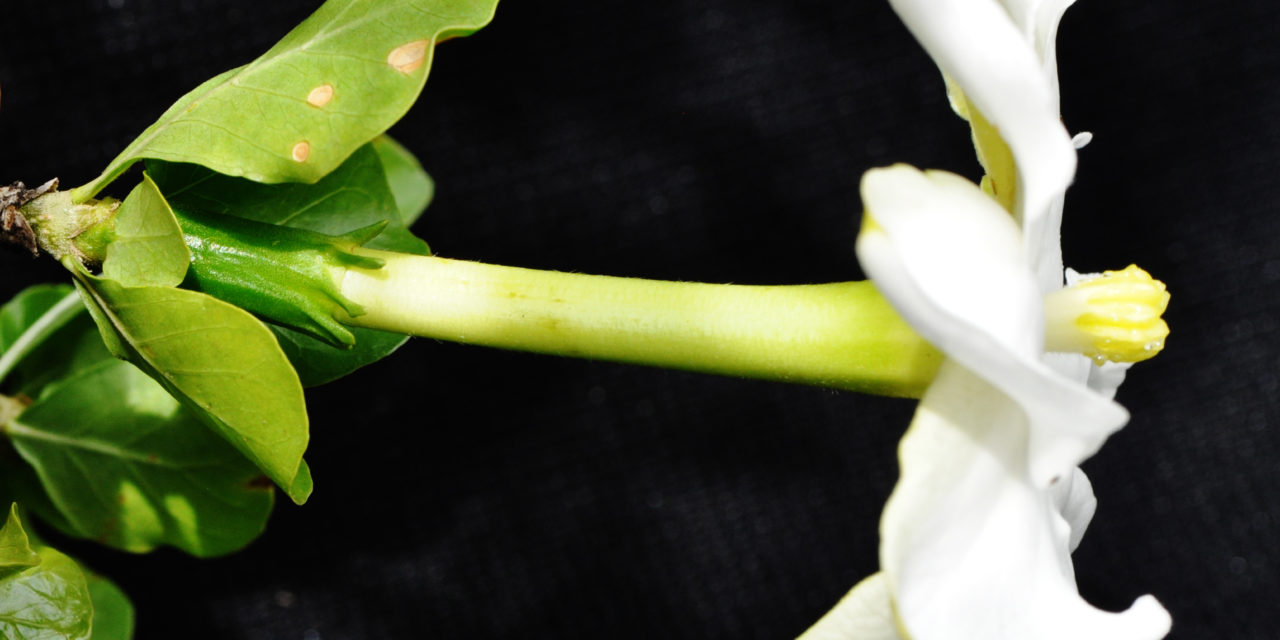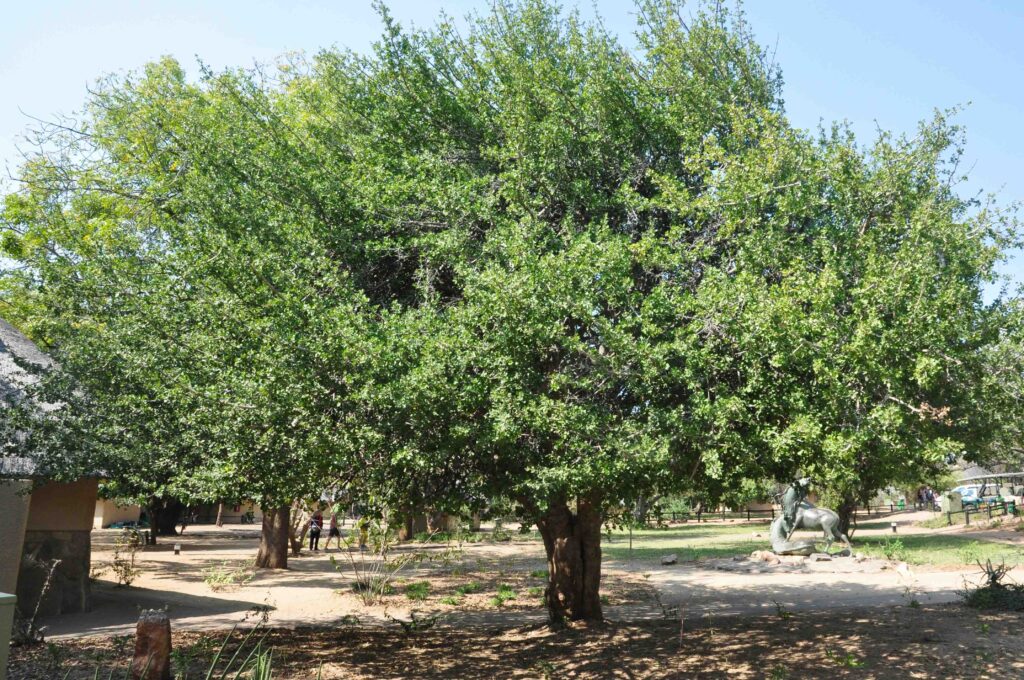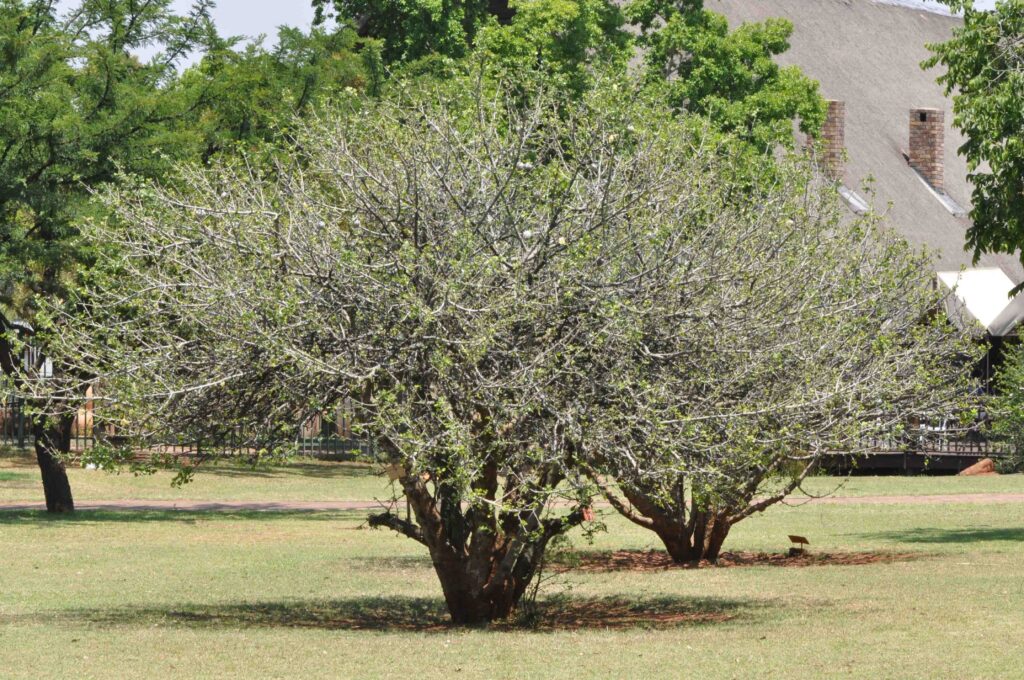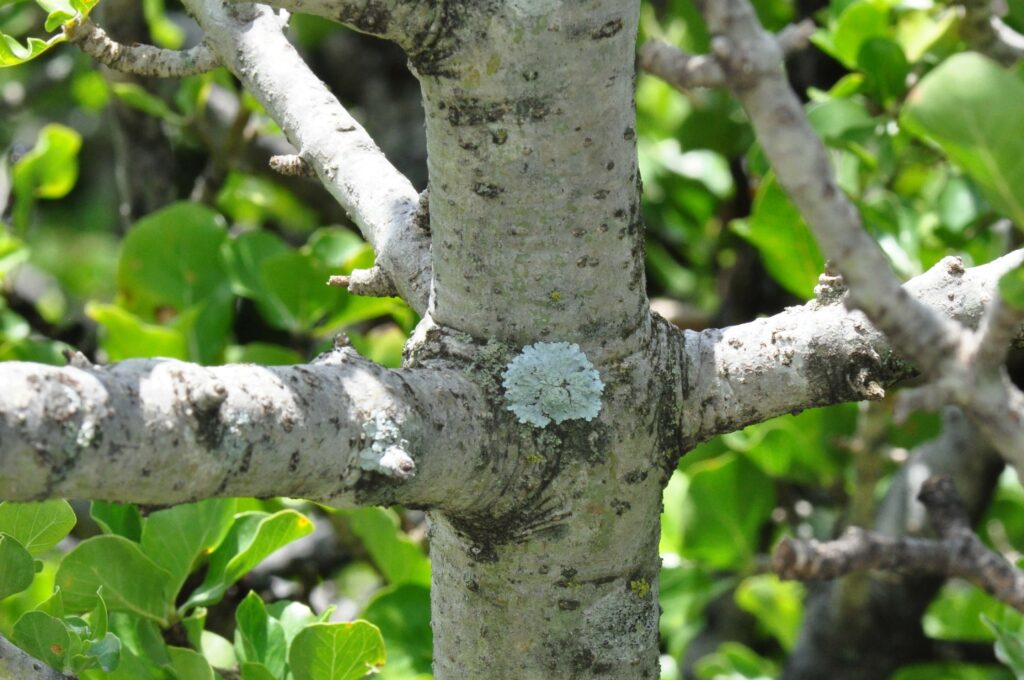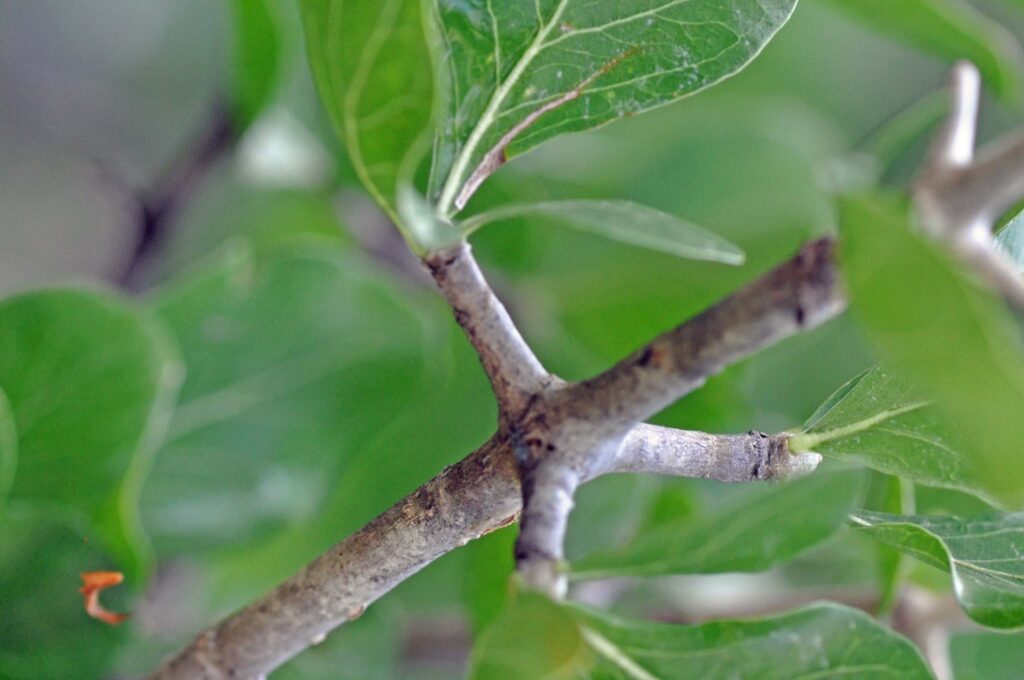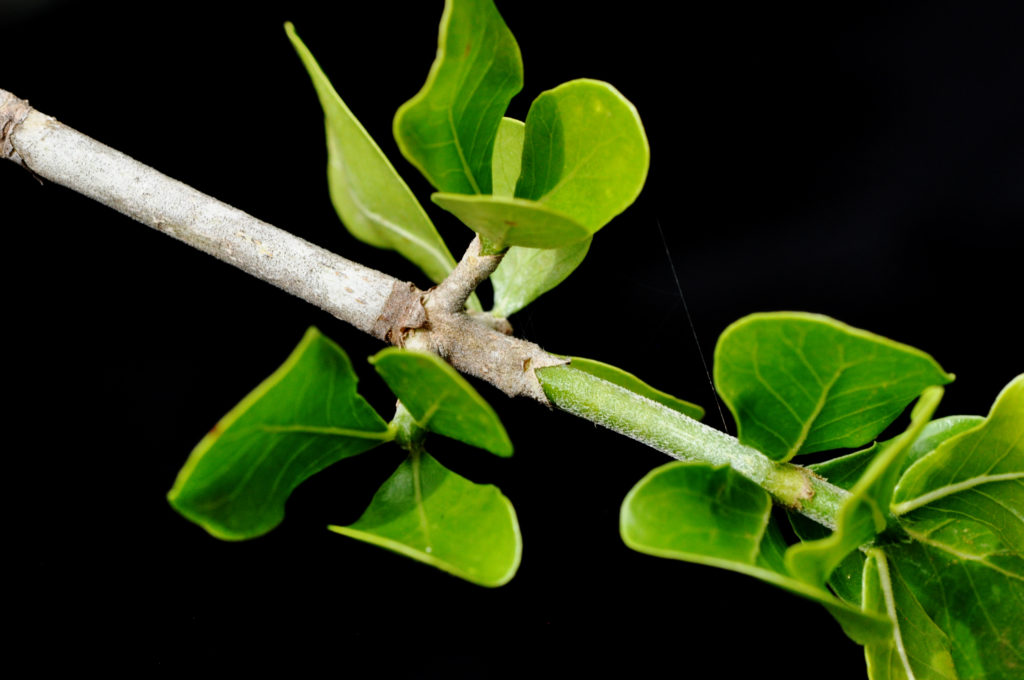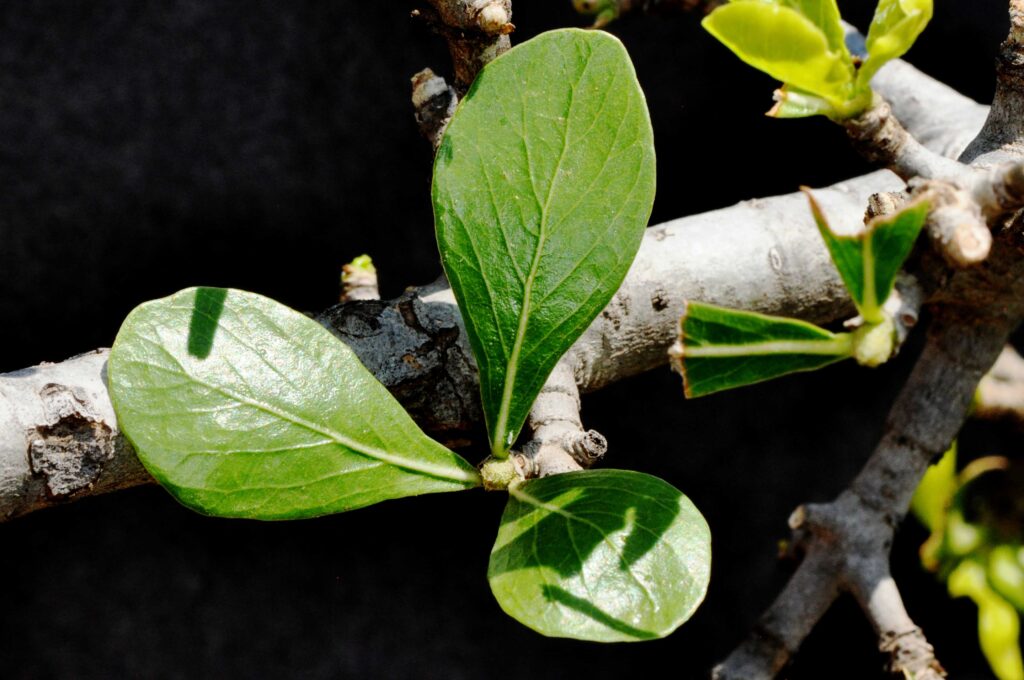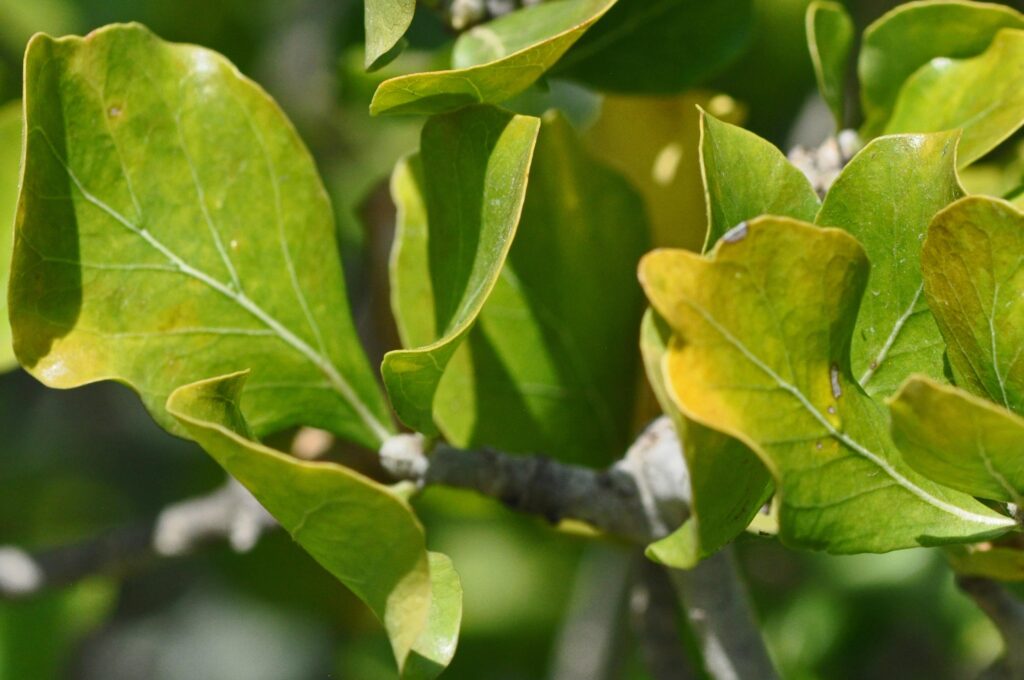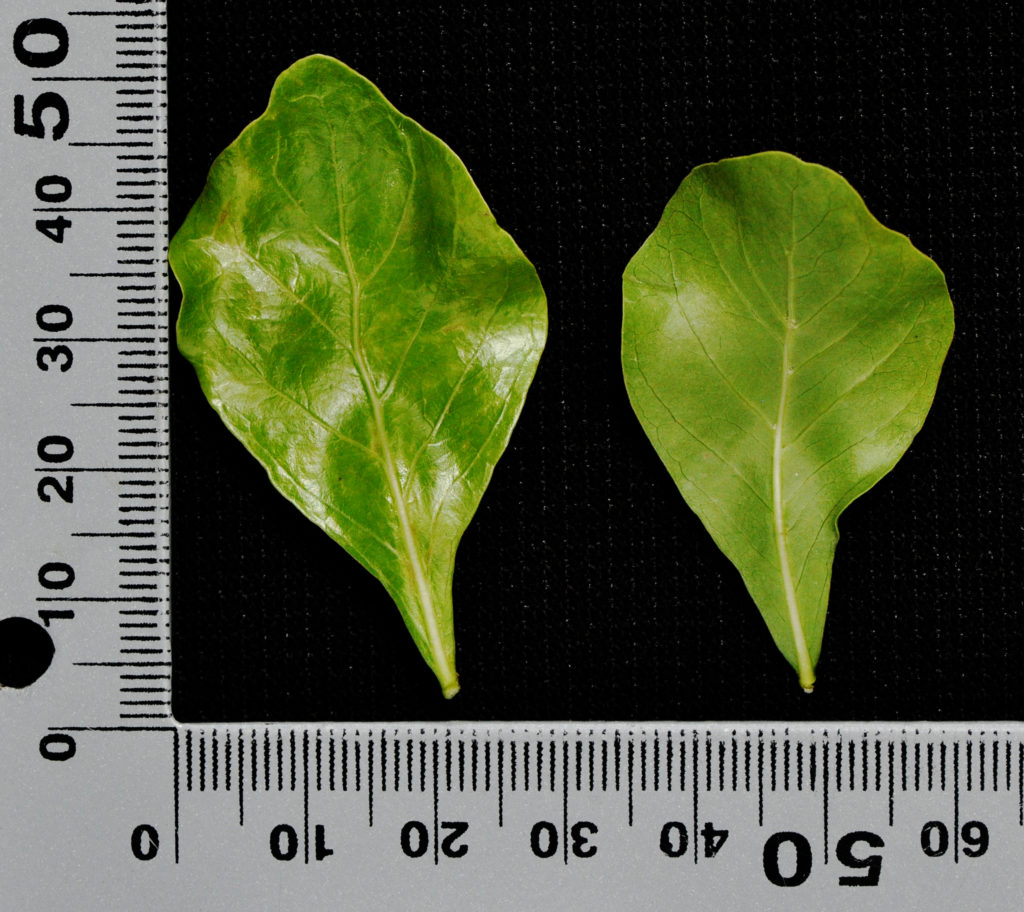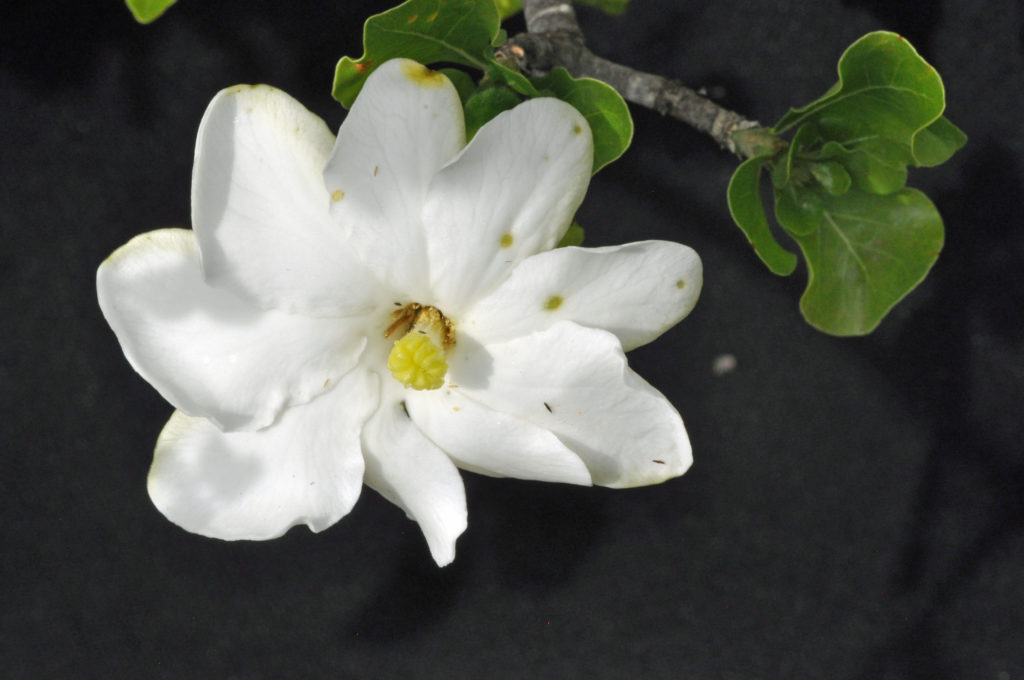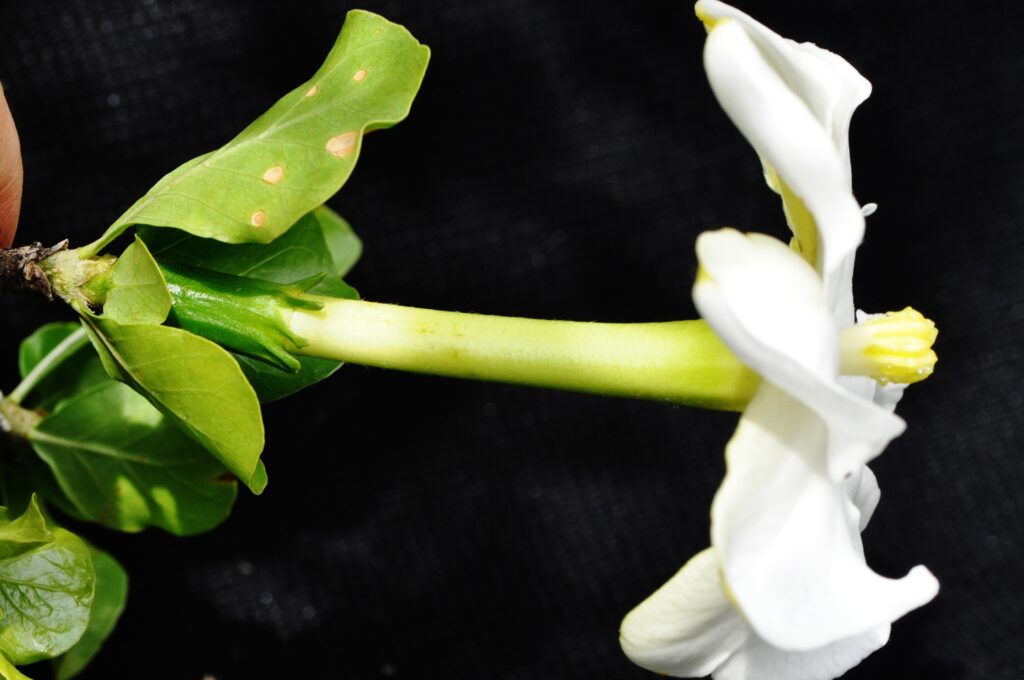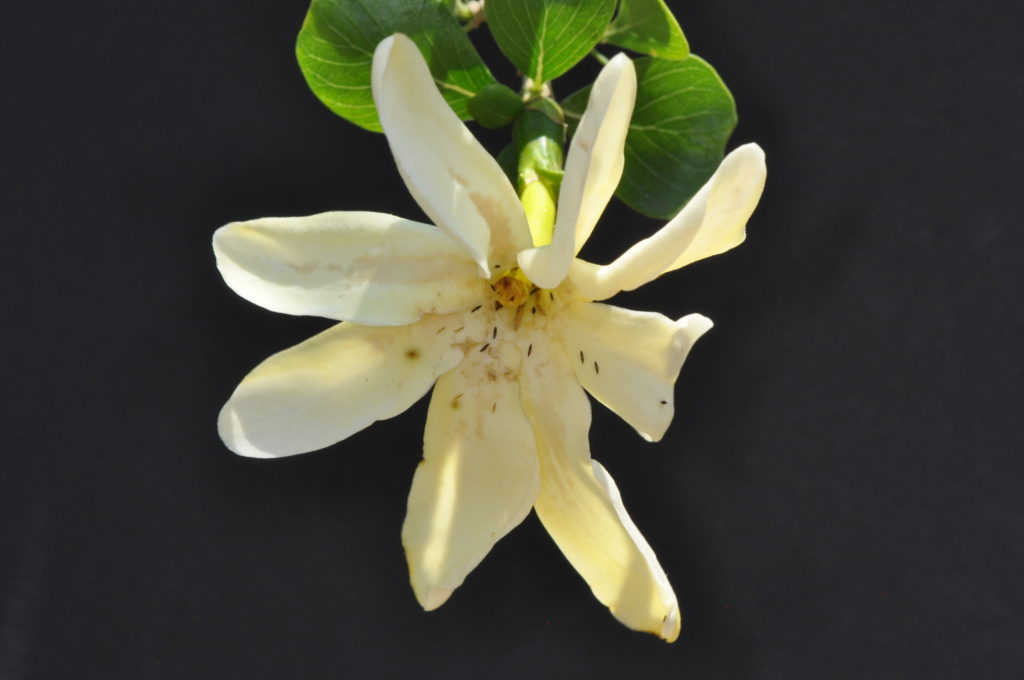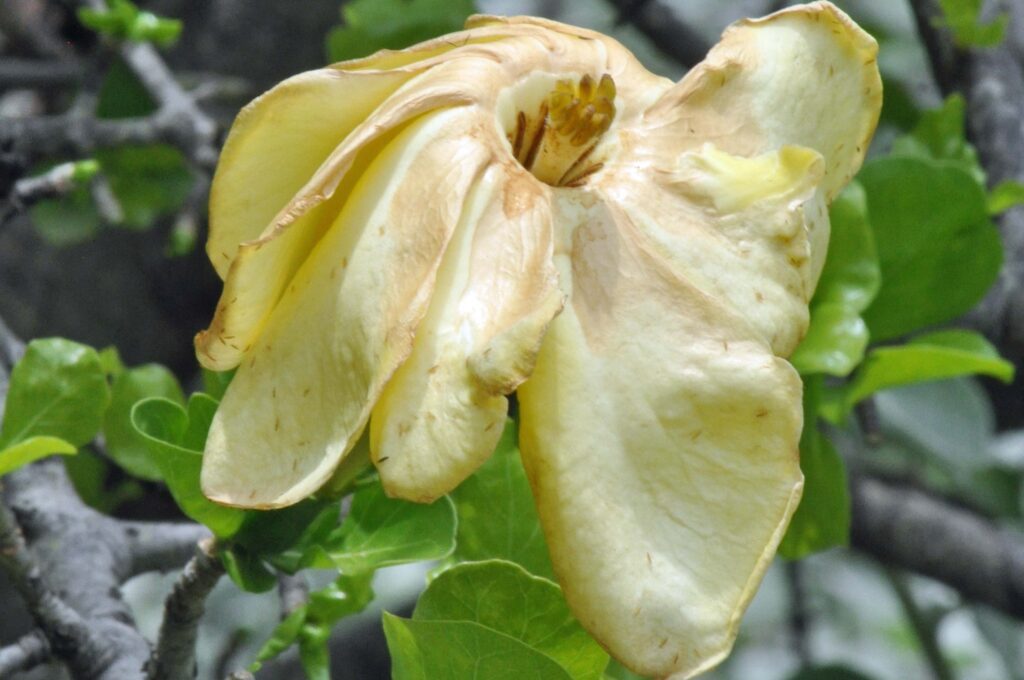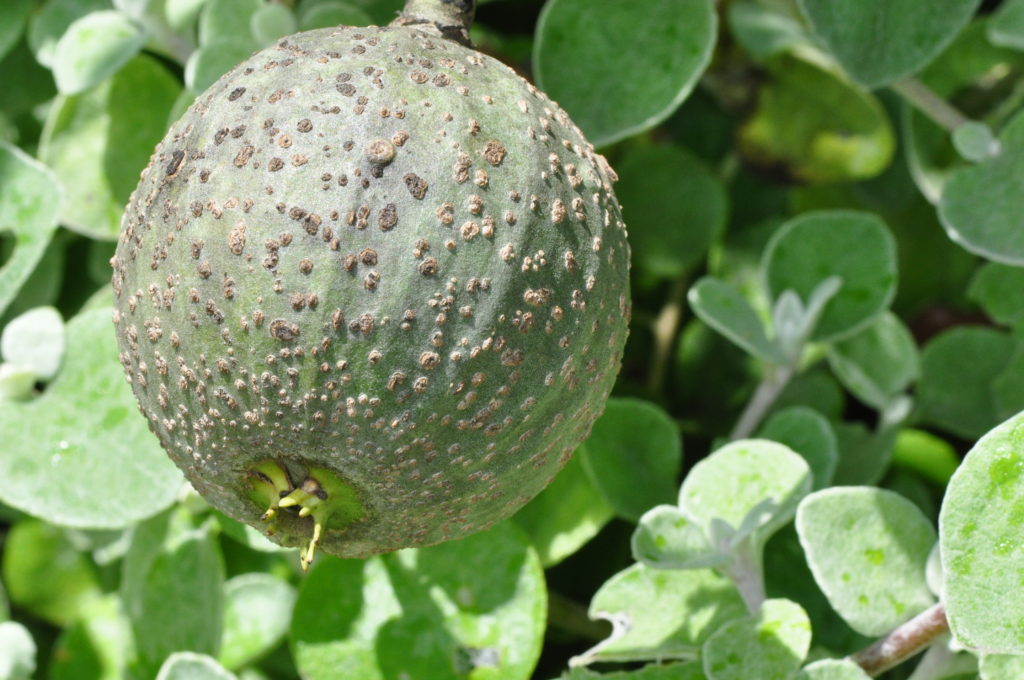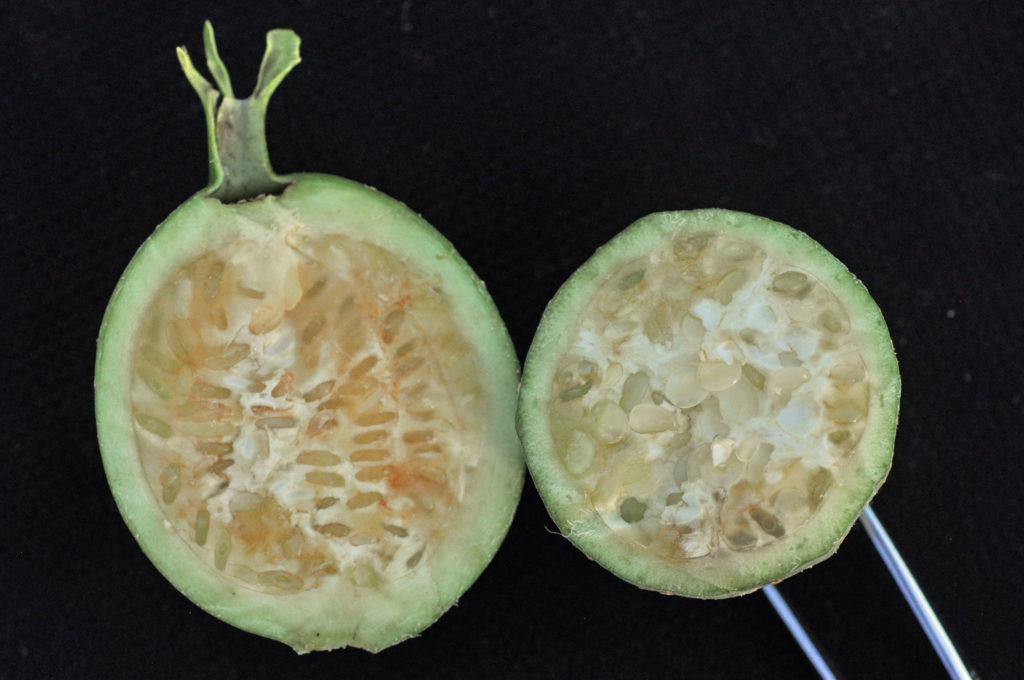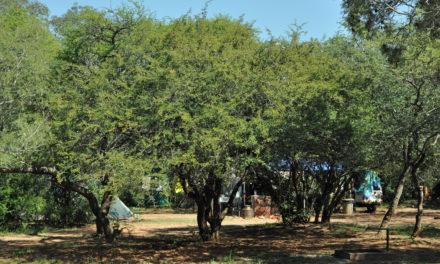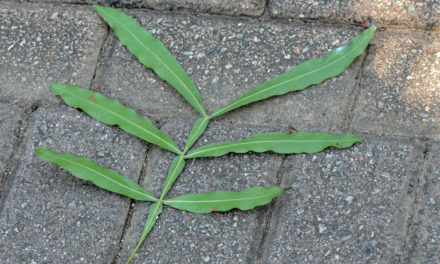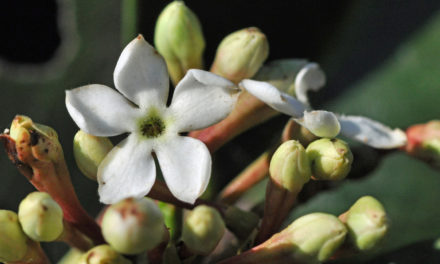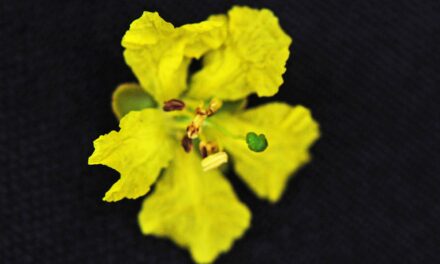General Info – summary
This shrub/small deciduous Tree is up to 10m high with a vastly spreading crown. Blunt ending branchlets occur in whorls of 3. Obovate, decurrent Leaves at branch ends. Large, white, striking, short-lived single Flowers turn yellow & are Hawk Moth pollinated. Anthers are not exerted, and the yellow stigma is swollen. Large, indehiscent Fruit has hard stalk & wart-like lenticels. Small, flat Seeds develop in pulp.
Description
Gardenia volkensii {subsp. spatulifolia}.
Previous name: Gardenia spatulifolia.
SA Tree No. 691.
Common names: (Afr) Bosveld Gardenia, Bosveldkatjiepiering, Savannakatjiepiering, Stompdoring (refers to the short, blunt branchlets), Transvaalse katjiepiering. (Eng) Bushveld Gardenia, Eastern bushveld Gardenia, Savanna Gardenia, Transvaal Gardenia, Umvala Gardenia, Wild Gardenia, Woodland Gardenia. (isiZulu) Ivalasangwiane, Umgongwane, Umkwakwane Onkhulu, Umvalasangweni. (Northern Sotho) Morala. (Setswana) Morala. (siSwati) Sivalasangwane, Umvalasangweni. (Tshivenda) Tshiralala.
Family Rubiaceae: Rubiaceae (Coffee family). This family of dicotyledonous plants has in excess of 600 genera and about 13 000 species and members include trees, shrubs and herbs including climbers. Local genera with trees on this website include Afrocanthium, Canthium, Coddia, Gardenia, Pavetta, Rothmannia and Vangueria. Leaves are simple, opposite or whorled and have interpetiolar stipules that may be reduced or fused to form a sheath. Flowers are bisexual or unisexual. The calyx has sepals that are at least partly united. Petals are joined – at least at the base. Blue butterflies in the family Lycaenidae are involved in pollination. Stamens are usually as many, as and alternating with corolla lobes. The Ovary is inferior. Fruit is a drupe, berry or capsule. In this family, there are 228 South African species.
Name derivation: Gardenia – named after Alexander Garden who died in 1791. He was a Scottish physician and plant collector who moved to South Carolina. He was also interested in insects. volkensii – named after a German botanist: L A Volkens (1885-1917) who collected plants on Mount Kilimanjaro, Egypt and Arabia. About 7 Gardenia species occur in the South Africa. spatulifolia – shaped like a spatula – referring to the leaves.
Conservation: National Status: L C. (Least Concern). Assessment Date: 2005 (W. Foden and L. Potter).
Tree
The small, usually rigid and possibly multi-stemmed plant may be a Tree up to a maximum of 10m high and has a sturdy Trunk up to 30cm in diameter. It may also remain a shrub. The Bark (photos 499 & 496) is white or light grey and is smooth or flaking – leaving yellowish patches. The many thick branchlets (usually applied to branches of the current or preceding year) are rigid, in whorls of 3, and protrude close to right angles from the stem (photo 496). These branchlets end bluntly (photo 496). The plant has a dense, much branched spreading crown with occasional arching branches. The spread of this plant is usually greater than its height (photos 65 & 564). Blunt Spines may be present. Young stems are hairy.
- 65. 2019./08/12. Gardenia volkensii subsp volkensii. KNP. Photo: David Becking..
- 564. 2014/10/30. Pretoria NBG. Photo: David Becking.
- 499. 2014/02/25. Walter Sisulu NBG. Photo: David Becking.
- 496. 2016/02/16. Walter Sisulu NBG. Photo: David Becking.
Leaves
On this deciduous tree, the variable Leaves may be opposite but are usually in whorls of 3 (photo 602) and crowded towards the ends of short rigid branchlets (photo 557). Leaves are usually quite small but may reach 8 x 5cm. Juvenile leaves are narrowly elliptic. Mature leaves are obovate (upside down egg-shaped), glossy dark green and shiny above (photo 557) and somewhat lighter and less shiny below. Present are air-tuft Domatia (a tiny chamber produced by plants that house arthropods. To the naked eye, the domatia appear as small bumps). Domatia are usually hairless and smooth (photo 72), but slightly rough hairs may be present. They are intended to be used by organisms that have a symbiotic relationship with the plant and are usually present in the axils of lateral veins (photo 670). The Apex is broadly tapering, rounded or flat-topped. The Base tapers narrowly. The wavy Margin may appear almost serrated. The absent or short Petiole (leaf stalk) may be obscured by the leaf blade – which is decurrent (leaf blades that partly wrap or have wings around the stem or petiole photo 72). Stipules (basal appendages of the petiole) are ovate, triangular (photo 602), 2-5mm long and persistent making the Branchlets knobbly.
- 602. 2015/10/20. Walter Sisulu NBG. Photo: David Becking.
- 557. 2014/10/30. Pretoria NBG. Photo: David Becking.
- 670. 2015/09/22. Walter Sisulu NBG. Photo: David Becking.
- 72 (2). 2015/10/27. Walter Sisulu NBG. Photo: David Becking.
Flowers
The rather untidy plant transforms when the flowers develop and becomes an arresting site. The large (up to 8cm wide), single, night opening Flowers have a sweet, heavy scent. They often appear in big numbers, especially after a good rain. Although each large flower is short-lived, the flowers open in succession thus extending the flowering season (photo examples below). They are borne singly, at the ends of branchlets (photo 597). The short, green Calyx sepals end in short pointed lobes (photo 601) and have a slit down one side. The usually 8–lobed Corolla has a narrow yellowish green tube up to 8cm long (photo 601). This long tube and tough calyx makes it difficult for birds and most insects to reach the nectar. The corolla ends with 6 to 9 spreading waxy white lobes, which bend backwards. The next day they tend to fade and turn creamy or yellowish as the flowers age (photos 555 & 600). There are as many Stamens as corolla lobes with which they alternate. The Anthers are not exserted. There is a single Pistil (a unit of the Gynoecium, the female element of the flower is composed of the Ovary, Style and Stigma). The Ovary is inferior, and the wide swollen Stigma is yellow (photo 597). The flowers are Pollinated by night flying, Hawk Moths in the family Sphingidae. They have long enough mouthparts to reach the nectar. These moths are agile and have a sustained flying ability. (Jul-Dec).
- 597. 2015/10/20. Walter Sisulu NBG. Photo: David Becking.
- 601. 2015/10/20. Walter Sisulu NBG. Photo: David Becking.
- 555. 2014/10/30. Pretoria NBG. Photo: David Becking.
- 600. 2015/10/20. Walter Sisulu NBG. Photo: David Becking.
Fruit
The woody, hard, heavy and ovoid to almost spherical or ellipsoidal Fruit is up to 11 x 10cm and terminates with a persistent Calyx (both photos below). The indehiscent fruit is shiny green when young becoming grey and shallowly or steeply ribbed lengthwise with intermittently scattered wart-like Lenticels (usually raised corky oval or elongated area on the plant that allows the uncontrolled interchange of gases with the environment – photo 497). In both photos below, the remains of the calyx is visible. A stout Stalk holds the fruit in position. The fruit shines in the sunlight and may remain on the tree for months. The many oval, and flattish Seeds are imbedded in the pulpy interior (photo 549). In subsp. spatulifolia fruit is smaller and shallowly ribbed and confined to Limpopo Province. (Nov-May).
- 497. 2014/02/25. Walter Sisulu NBG. Photo: David Becking.
- 549. 2017/01/24. Walter Sisulu NBG. Photo: David Becking.
Distribution & Ecology
These Trees are common in the bushveld (a sub-tropical woodland ecoregion of southern Africa), mixed deciduous woodland, and are often associated with termite mounds. They can be seen in low-lying areas or on hill slopes within an altitude range of 100 – 1 500m. Location: In South Africa, they occur in KwaZulu-Natal, Limpopo and Mpumalanga. They also occur in Botswana, mainly southern Mozambique, NE Namibia and into tropical Africa. Larvae of the Butterfly, the Apricot Playboy (Deudorix dinochares) feed on the Leaves. Flight period is year round peaking in Sep-Oct. Elephants eat all parts of the Plant. Big antelopes, including nyala, eat the Fruit.
Ethnobotany
The fine grained, light coloured Wood is hard, dense and though small is useful for making spoons, carving ornaments and for firewood. These plants are attractive in a garden. Usually, this plant is easily propagated by germinating seeds or by using truncheons (stem cutting from a selected plant – used to produce genetically identical new plants). Young plants are frost sensitive. They grow best in summer rainfall areas in warm locations. The Trees are relatively slow growing and used for bonsai. The Fruit may be poisonous. Some people believe they have magical properties, and these plants may be conserved as a protection against lightning. Local medicine also makes use of this plant.
References
Boon, R. 2010. Pooley’s Trees of eastern South Africa. Flora and Fauna Publications Trust, Durban.
Burrows, J.E., Burrows, S.M., Lotter, M.C. & Schmidt, E. 2018. Trees and Shrubs Mozambique. Publishing Print Matters (Pty) Ltd. Noordhoek, Cape Town.
Coates Palgrave, M. 2002. Keith Coates Palgrave Trees of Southern Africa, edn 3. Struik, Cape Town.
SANBI. 2020. Gardenia volkensii K.Schum. subsp. volkensii var. volkensii. National Assessment: Red List of South African Plants version 2020.1. Accessed on 2023/07/02.
Lawrence, G. H. M, 1951. Taxonomy of Vascular Plants, The Macmillan Company, New York. Tenth Printing 1965.
Palmer, E. & Pitman, N. 1972. Trees of southern Africa, Balkema, Amsterdam, Cape Town.
Schmidt, S. Lotter, M. & McCleland, W. 2002. Trees and Shrubs of Mpumalanga and the Kruger National Park.
van Wyk, B. & van Wyk, P. 1997 Field guide to Trees of Southern Africa, Struik, Cape Town.
Woodhall, S. 2020. Field Guide to BUTTERFLIES of South Africa. Struik.
http://www.fs.fed.us/wildflowers/pollinators/pollinator-of-the-month/hawk_moths.shtml
http://plantzafrica.com/plantefg/gardeniavolk.htm
http://www.zimbabweflora.co.zw/speciesdata/species.php?species_id=155380
https://en.wikipedia.org/wiki/Rubiaceae

